Using qualitative risk assessment as a leading indicator for geotechnical risk in mining

|
Authors: Hamman, ECF; Venter, J |
DOI https://doi.org/10.36487/ACG_rep/1905_05_Hamman
Cite As:
Hamman, ECF & Venter, J 2019, 'Using qualitative risk assessment as a leading indicator for geotechnical risk in mining', in J Wesseloo (ed.), MGR 2019: Proceedings of the First International Conference on Mining Geomechanical Risk, Australian Centre for Geomechanics, Perth, pp. 127-156, https://doi.org/10.36487/ACG_rep/1905_05_Hamman
Abstract:
Investor confidence is largely driven by a mining company’s ability to deliver on the guaranteed return on investment. Thus, robust due diligence processes, functioning as part of a mining company’s corporate governance, become essential tools to identify hazards that can impact production, assess the associated risks and introduce controls to manage the risks. The geotechnical practitioner is tasked to manage one of the biggest risks on the mine; that of a rock mass instability. Since an instability, or collapse, need not be large to have a significant impact on production, the challenge is to develop an optimised life-of-mine design with a risk management plan that suits the risk requirements of the mining company and investors, whilst meeting acceptable, minimum safety standards. The concept of a Geotechnical Review Board has been adopted in the industry as a vehicle to provide assurance that the geotechnical risks on a mine have been identified and are being properly managed. The review relies on external parties providing appraisals of the design and processes, and experienced oversight of the active operations. In general, these reviews tend to have a unique style; often a combination of the current, visible, critical issues on the mine and issues deemed as important by either the reviewer or a third party. Coupled with the challenge of fluidity in modern planning environments, the geotechnical practitioner is often still faced with uncertainty in the level of geotechnical risk associated with any given mine plan. This paper introduces a geotechnical risk assessment tool that has been developed for use as a leading indicator within AngloGold Ashanti’s international operations. The authors aim to provide the reader with insight into how the tool can be utilised to understand a mine’s ability to proactively identify and manage geotechnical hazards, by exploring the following components:
Keywords: risk management, leading indicators, event tree, qualitative risk assessment, reliability
References:
Accreditation Board for Engineering and Technology 1987, Fifth Annual Report, Accreditation Board for Engineering and Technology Washington DC.
Basson, FRP & Dunn, MJ 2009, Numerical Modelling Guidelines for Underground Mines, internal document, Newmont Asia Pacific.
Bieniawski, ZT 1991, ‘In search of a design methodology for rock mechanics’, in J-C Roegiers (ed.), Rock Mechanics as a Multidisciplinary Science: Proceedings of the 32nd US Symposium on Rock Mechanics, A.A. Balkema, Rotterdam, pp. 1027–1036.
Bieniawski, ZT 1992, ‘Invited paper: Principles of engineering design for rock mechanics’, in JR Tillerson & WR Wawersik (eds), Rock Mechanics: Proceedings of the 33rd US Symposium on Rock Mechanics, A.A. Balkema, Rotterdam, pp. 1031–1040.
Davies, E 1967, Report of the Tribunal Appointed to Inquire into the Disaster at Aberfan on October 21st 1966, Her Majesty's Stationery Office, London, pp. 131–132.
Hamman, ECF 2003, ‘A methodology for geotechnical hazard and risk reviews on open pit mines’, Proceedings of The First African Young Geotechnical Engineers Conference, International Society for Soil Mechanics and Geotechnical Engineering, London.
Hamman, ECF 2009, ‘Qualitative geotechnical hazard and risk assessment’, Proceedings of the 2009 International Symposium on Rock Slope Stability in Open Pit and Civil Engineering, University de los Andes, Santiago.
pp. 461–488.
Harley, E 2011, Group Risk Management Guidelines, internal document, AngloGold Ashanti.
Harr, ME 1996, Reliability-based Design in Civil Engineering, Dover Publications, New York.
International Organization for Standardization 2008, ISO/DIS 31.000: Risk Management Principles and Guidelines on Implementation, International Organization for Standardization, Geneva.
Kamien, DJ 1995, Introduction to Probability and Reliability Methods for use in Geotechnical Engineering, Engineering Technical Letter No. 1110-2-547, The US Army Corps of Engineers, Washington DC.
Lilly, PA 2000, Risk Analysis and Decision Making, unpublished Master of Engineering Science course notes, Curtin University, Perth.
McMahon, BK 1978, Application of Rock Mechanics to Mine Design, Australian Mineral Foundation, Glenside.
Naismith, WA 1998, Hazard Identification for Rock Engineering, SIMRAC Report - GAP 339, Department of Mineral and Energy Affairs, Pretoria.
Read, JRL 2009, ‘Data uncertainty’, in JRL Read & P Stacey (eds), Guidelines for Open Pit Slope Design, CSIRO Press, Collingwood,
pp. 213–220.
Read, JRL & Stacey, P 2009, Guidelines for Open Pit Slope Design, CSIRO Press, Collingwood.
Silwamba, C & Chileshe, PKR 2016, ‘Radar slope management at Nchanga open pit mine Zambia: footwall failure of November 2014’, International Journal of Research Science and Management, May 2016, pp. 10–22.
Stacey, TR 2009, ‘The importance of engineering design with regard to safety in mining’, Proceedings of the International Symposium on Hard Rock Safe Safety Conference, South African Institute of Mining and Metallurgy, Johannesburg, pp. 291–304.
Sullivan, TD 2006, ‘Pit slope design and risk – a view of the current state of the art’, Proceedings of the 2006 International Symposium on Stability of Rock Slopes in Open Pit Mining and Civil Engineering, South African Institute of Mining and Metallurgy, Johannesburg, pp. 51–78.
Terbrugge, PJ, Wesseloo, J, Venter, J & Steffen, OKH 2006, ‘A risk consequence approach to open pit slope design, Proceedings of the International Symposium on Stability of Rock Slopes in Open Pit Mining and Civil Engineering, South African Institute of Mining and Metallurgy, Johannesburg, pp. 81–96.
Wiles, TD 2006, ‘Reliability of numerical modelling predictions’, International Journal of Rock Mechanics and Mining Sciences, vol. 43, no. 3, pp. 454–472.
© Copyright 2025, Australian Centre for Geomechanics (ACG), The University of Western Australia. All rights reserved.
View copyright/legal information
Please direct any queries or error reports to repository-acg@uwa.edu.au
View copyright/legal information
Please direct any queries or error reports to repository-acg@uwa.edu.au
